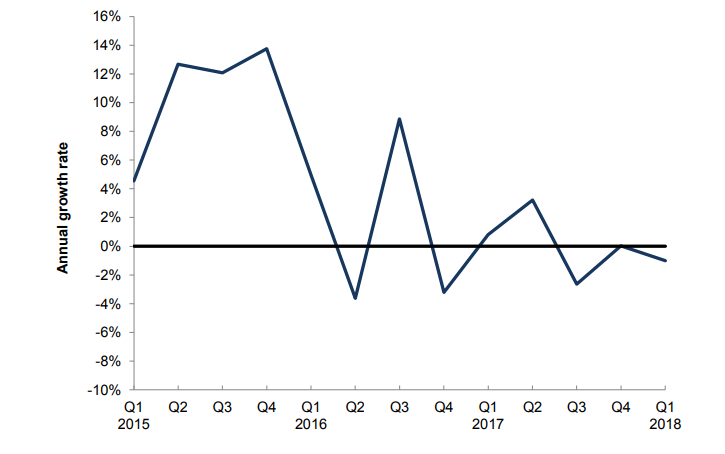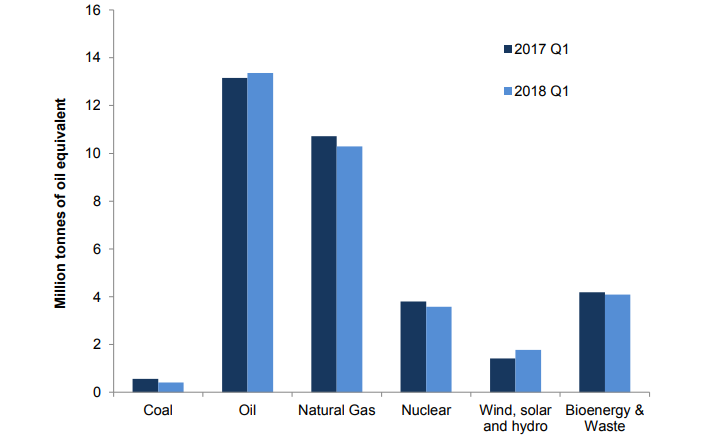The UK Department for Business, Energy and Industrial Strategy issued its ‘Energy Trends’ report for the first quarter of 2018, revealing that the country’s total energy production was 1.0% lower than in the first quarter of 2017, despite increased oil output and record high output from wind, solar and hydro.
Total primary energy consumption for energy uses rose by 3.3%. However, when adjusted to take account of weather differences between the first quarter of 2017 and the first quarter of 2018, primary energy consumption fell by 1.6%. The average temperature in the first quarter of 2018 was 4.5 degrees Celsius, 1.9 degrees Celsius lower than the same period a year earlier
Final consumption rose by 6.5% compared to the first quarter of 2017. Domestic consumption rose by 13.2% reflecting the colder weather in the quarter, other final users’ consumption rose by 10.7 per cent, transport consumption rose by 1.6%, and industrial consumption rose by 1.0%.
Net import dependency was 41.4%, up 4.3 percentage points from the first quarter of 2017.

Key findings
- Total energy production was 1.0% lower than in the first quarter of 2017. • Oil production rose by 1.4 per cent when compared to the first quarter of 2017.
- Natural gas production was 4.1% lower, following particularly strong production levels in the first quarter of 2017.
- Coal production in the first quarter of 2018 was 27% lower than the first quarter of 2017, due to falling demand. Coal imports were 30% higher while generators’ demand for coal fell by 13%.
- Total primary energy consumption for energy rose by 3.3%. However, when adjusted to take account of weather differences between the first quarter of 2017 and the first quarter of 2018, total primary energy consumption fell by 1.6%.
- Temperatures in the quarter were on average 1.9 degrees colder than a year earlier, with average temperatures in both February and March being colder than a year earlier.
- Final energy consumption (excluding non-energy use) was 7.0% higher than in the first quarter of 2017. Domestic consumption rose by 13.2 per cent due to colder weather. On a seasonally and temperature adjusted basis final energy consumption rose by 0.5%, within which domestic consumption fell 1.3%.
- Gas demand was 7.4% higher than the first quarter of 2017, whilst electricity consumption was 2.0% higher, both driven by the colder weather in the first quarter of 2018.
- Electricity generated in the first quarter of 2018 fell 1.1% compared to 2017 Q1, by 1.0 TWh to 92.8 TWh, however net imports rose 5.4 TWh over the same period, leading to a 1.8% rise in electricity supplied.
- Coal’s share of generation decreased from 11.1% to 9.4%, whilst gas’s share fell from 40.5% to 39.9 per cent. Nuclear’s share of generation fell from 18.8% in the first quarter of 2017 to 17.9% in the first quarter of 2018.
- Low carbon electricity’s share of generation increased from 45.8% in the first quarter of 2017 to 48.0% in the first quarter of 2018.
- Renewables’ share of electricity generation increased to a record quarterly high of 30.1%, compared to the 27.0% share in the first quarter of 2017, due to increased wind and solar capacity and higher wind speeds.
- Renewable electricity generation was a record 27.9 TWh in the first quarter of 2018, an increase of 10.2% on the same period a year earlier.
- Renewable electricity capacity was a record 41.9 GW in the first quarter of 2018, an increase of 11.2% on the same period a year earlier.

Explore more herebelow:































































